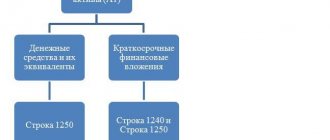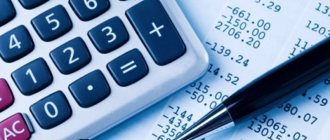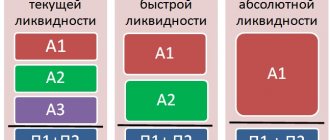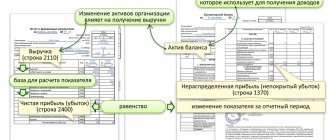Net working capital: economic meaning of the indicator
For analysis purposes, Net Working Capital can be calculated in several ways. Calculation options are presented in the diagram; their description is given below.
In general terms, Net Working Capital is the difference between current assets and current liabilities. The formula for Net Working Capital is:
NWC = TCA – TCL
Where
- NWC – net working capital
- TCA (Total Current Assets) – current assets
- TCL (Total Current Liabilities) - current liabilities
Current assets include:
- cash and cash equivalents (Cash and Cash Equivalents), in the form of account balances, cash desks, bills of exchange, other securities quickly sold without loss of value, deposits;
- stocks of raw materials, materials and finished products (Inventory);
- VAT on the assets that were purchased (VAT);
- Accounts Receivables.
Current liabilities consist of:
- debt on short-term loans (Short-term liabilities);
- accounts payable (Account Payables);
- advances received (advance payments), etc.
Net working capital is the part of current assets financed by long-term financial resources (equity and long-term liabilities).
Net working capital is used to determine solvency in the short term, lasting up to a year.
The calculated NWC indicator shows the amount of the balance of current assets after repayment of short-term debt. It is NWC that the enterprise can use for its further development.
Net working capital is also called working capital. In English the term Working capital is used.
Financial cycle
The financial cycle of an enterprise is the period of time required for current assets and liabilities to be converted into cash. In other words, this is the time required for one complete turnover of working capital. As a rule, the shorter its duration, the lower the costs associated with servicing the financing.
Formula
To calculate the duration of the financial cycle, the following formula is used:
Financial cycle = DSO + DSO - DPO
where DSI is the inventory turnover period in days ( Days Sales of Inventory
), DSO – collection period for receivables in days (
English: Days of Sales Outstanding
), DPO – repayment period for accounts payable (
English: Days of Payables Outstanding
).
In turn, the above indicators are calculated using the following formulas:
| DSI= | Reserves | × 365 |
| Cost of goods sold |
| DSO = | Accounts receivable | × 365 |
| Revenue from sales on credit |
| DPO = | Accounts payable | × 365 |
| Purchases on credit |
Obviously, the duration of the financial cycle can be reduced either by increasing the repayment period of accounts payable, or by reducing the period of inventory turnover and the collection period of receivables. However, each of these methods has its drawbacks.
Reduced inventory levels can lead to production problems and thus lead to decreased sales. To reduce the collection period for receivables, an enterprise must introduce a more stringent credit policy, which can also have a negative effect on sales volume. In turn, increasing the maturity of accounts payable will lead to its growth in the balance sheet, which will lead to a decrease in liquidity indicators and will be negatively perceived by the company’s creditors.
Net working capital: balance sheet calculation formula
The calculation of net working capital (NWC) on the balance sheet is carried out using the formula:
CHOC = OA – KO
where ОА – current assets; KO – short-term liabilities
or by balance sheet line codes:
NER = page 1200 – page 1500
Where
- line 1200 – current assets (total for section II of the balance sheet)
- line 1500 – short-term liabilities (total for section V of the balance sheet)
The NER indicator can be used as a criterion for the liquidity of an enterprise. Its positive value (the excess of current assets over short-term liabilities) indicates that the enterprise has sufficient liquid assets to pay all current obligations. For investors and creditors, this indicates the solvency of the enterprise. And also that it can develop at the expense of internal reserves.
A negative NER value (the excess of short-term liabilities over current assets) indicates negative liquidity. The enterprise does not have the funds to maintain current assets and financial stability. Covering the need for current assets is carried out exclusively at the expense of earthly capital. There may be a need for additional financing from the owners.
A negative NER value of the indicator indicates losses, which, in the worst case scenario, can lead to bankruptcy. Negative NER is a risk for investors, borrowers and suppliers. If the NER is negative, you should consider changing the structure of short-term borrowings, for example, converting them to long-term ones.
However, an excessively large NWC value indicates wasteful use of resources, overstocking, a significant amount of receivables and excess inventories. As a result of inefficient farming, the enterprise will experience a shortage of current funds.
Concept and structure of current assets
As you know, current assets are assets that serve or are repaid within 12 months, or during the normal operating cycle of the organization (if it exceeds 1 year).
Many current assets are used simultaneously when they are released into production (for example, raw materials).
Current assets are one of two groups of assets of an organization (the second is non-current assets). They are also called current assets.
Composition of current assets
In accordance with the form of the balance sheet, current assets include:
- stocks;
- VAT on purchased assets;
- accounts receivable;
- financial investments (except for cash equivalents);
- cash and cash equivalents;
- other assets that meet the criteria of current assets.
Accounts receivable and financial investments are classified as current assets only if their maturity period is less than 1 year, or the period exceeds 1 year, but the organization is confident in the high liquidity of these assets and the ability to quickly and without loss convert them into cash (i.e. e. sell).
Current assets, in principle, have a higher degree of liquidity than non-current assets. And money, as part of current assets, has absolute liquidity.
In their movement, current assets go through three successive stages of circulation: monetary, productive and commodity.
The first stage of the circulation of working capital is monetary. At this stage, cash is converted into the form of inventory.
The second stage is productive. At this stage, the cost of the created products continues to be advanced, but not in full, but in the amount of used production reserves; wage costs are advanced, as well as the transferred part of fixed assets.
At the third stage of the circuit, the product of labor (finished products) continues to be advanced. And only after the commodity form of the newly created value turns into money, the advanced funds are restored at the expense of part of the proceeds received from the sale of products.
And the cycle begins again.
Working capital is the most mobile part of an enterprise's capital, which, unlike fixed capital, is more fluid and easily transformed into cash.
Working capital usually includes cash, marketable securities, inventories, unsold finished products, and short-term debt.
Own working capital or own working capital is the amount of current assets remaining at the disposal of the enterprise after the full, one-time repayment of the enterprise's short-term debt.
Today, the terms “current assets” and “working capital” are often used interchangeably. However, there is a certain difference between these concepts:
they are on opposite sides of the balance sheet;
current assets (balance sheet assets) are formed from working capital funds (balance sheet liabilities), the sources of which can be either own or borrowed, as a rule, in order to obtain a positive economic effect or for other purposes, which ultimately dictates the requirements for the organization of the management system current assets.
Net working capital is equal to the difference between current assets and short-term liabilities (liabilities).
That is, net working capital (NWC) is understood as the difference between the value of current assets (TA) and the value of current liabilities (without long-term current liabilities) (TO) of the organization as of the reporting date:
CHOC = TA - TO
Net working capital is the amount of the enterprise's own funds used to finance operating activities. As a rule, these are liquid assets of the enterprise that can easily be converted into cash.
The amount of net working capital can take zero, positive and negative values.
Positive net working capital:
- means that part of current assets is formed from current liabilities;
- and also that part of the current assets is formed from invested capital.
Positive net working capital reduces the amount of net cash flow and indicates the amount to cover current needs with long-term sources of financing.
Negative net working capital:
- means that all current assets are financed by current liabilities;
- indicates the amount of coverage of investments in non-current assets with current liabilities;
- is a free source of financing operating and investment activities.
Negative working capital increases the amount of net cash flow, since it maximally involves creditors’ funds in intra-business turnover.
Zero net working capital:
- means that the amount of current assets corresponds to the amount of current liabilities.
In terms of assessing the financial needs of an enterprise, net working capital is considered to be an estimate of the working capital requirement.
Current assets for the purpose of calculating the amount of net working capital (NWC) are the following balance sheet items:
- stocks;
- accounts receivable;
- VAT on purchased assets;
- other current assets, including VAT on advances received, accrued revenue not presented for payment, shortages and losses from damage to valuables.
Current liabilities for the purpose of calculating the amount of net working capital (NWC) are the following balance sheet items:
- short-term and long-term accounts payable (including for investment activities);
- revenue of the future periods;
- short-term estimated liabilities;
- other short-term liabilities, including VAT on advances issued.
Net working capital can be divided into operating and investment capital.
Operating - net working capital related to the operating cycle.
In this case, the operating cycle is usually understood as a set of stages:
- purchasing materials from suppliers;
- payments to suppliers;
- production of products (provision of services, performance of work);
- shipment of finished products to customers;
- and receiving funds from customers.
The amount of net operating capital consists of the following elements:
CHOCoper. = OA - DS - FV - VHOoa - (KO - KK -KZinv. - VHOko ADDITIONAL)
Where:
OA - current assets;
DS - cash;
FV - financial investments for a period of up to 12 months;
ВХОоа - intra-economic turnover in terms of current assets
KO - short-term liabilities;
KK - short-term loans and borrowings;
KZ inv. — accounts payable for investment activities;
VHOKO - intra-economic turnover in terms of short-term liabilities
TO etc. - other long-term liabilities.
Net working capital investment - shows the contribution of funds in settlements under investment agreements to the net working capital of the company:
CHOC inv. = AVinv. — KZinv.
Where:
AVinv. — advances issued for investment activities;
KZinv. — accounts payable for investment activities.
It is also necessary to say about the assessment of the amount of net working capital , which reflects the contribution of funds in settlements to the net working capital of the company.
CHOC pl. = DZ - short circuit
Where:
CHOC pl. — net working capital;
DZ - accounts receivable;
KZ - accounts payable.
This indicator can be used, along with others, to manage liquidity and solvency.
A distinction is also made between the constant need for working capital and seasonal need.
Constant need is defined as the minimum irreducible amount (level) of working capital; seasonal need is a changing amount of working capital due to the influence of seasonal factors and business activity.
Calculation of the PSC of an enterprise using the example of DOK-15 LLC
The main activity of DOK-15 LLC is the production of kitchen furniture. Net working capital will be calculated using the formula:
NOL = Current assets – Current liabilities
We will take the data for calculations from the financial statements of the enterprise contained in the Rosstat database.
Table 1 — Balance sheet of DOK-15 LLC
The calculation of Net Working Capital is presented in Table 2.
Table 2 – Calculation of the value of NSC for DOK-15 LLC
| Index | 2018 | 2017 | ± | % |
| Cash, thousand rubles. | 308989 | 36317 | 272672 | 851 |
| Financial investments, thousand rubles. | 137634 | 0 | 137634 | X |
| Accounts receivable, thousand rubles. | 260376 | 151982 | 108394 | 1711 |
| Inventories, thousand rubles | 1993609 | 2022419 | -28810 | 99 |
| Value added tax, thousand rubles. | 204 | 76 | 128 | 2689 |
| Other current assets, thousand rubles. | 66178 | 63992 | 2186 | 1039 |
| Total current assets, thousand rubles. | 2766990 | 2274786 | 492204 | 122 |
| Borrowed funds, thousand rubles. | 21491 | 38917 | -17426 | 55 |
| Accounts payable, thousand rubles. | 1128564 | 687943 | 440621 | 164 |
| Total current liabilities | 1150055 | 726860 | 423195 | 158 |
| Net working capital (NWC): OA-KO, thousand rubles. | 1616935 | 1547926 | 69009 | 104 |
The data in the table shows that the value of NER, both in the past and in the reporting period, has a positive value. This indicates that the company's current assets exceeded its short-term liabilities. Moreover, the value of NSC in the reporting year increased compared to the previous year by 69,009 thousand rubles. and amounted to 1,616,935 thousand rubles. versus 1,547,926 thousand rubles. This indicates that the company has the funds to pay off short-term obligations and finance its activities.
Factor analysis of PSC DOK-15 LLC
At the next stage of the analysis, it is necessary to evaluate the factors of change in net working capital. This is necessary in order to identify the main reasons for the deterioration or improvement of the financial position of the enterprise. We will carry out factor analysis using the method of chain substitution. This method is universal, as it is used in all types of factor models.
Table 3 – Factor analysis of NSC
| Index | Symbol | T1 | T0 | ± | % |
| Cash, thousand rubles. | DS | 308989 | 36317 | 272672 | 851 |
| Financial investments, thousand rubles. | FV | 137634 | 0 | 137634 | X |
| Accounts receivable, thousand rubles. | DZ | 260376 | 151982 | 108394 | 1711 |
| Inventories, thousand rubles | Z | 1993609 | 2022419 | -28810 | 99 |
| Value added tax, thousand rubles. | VAT | 204 | 76 | 128 | 269 |
| Other current assets, thousand rubles. | OA pr | 66178 | 63992 | 2186 | 103 |
| Total current assets, thousand rubles. | OA | 2766990 | 2274786 | 492204 | 122 |
| Borrowed funds, thousand rubles. | ZK | 21491 | 38917 | -17426 | 5 |
| Accounts payable, thousand rubles. | short circuit | 1128564 | 687943 | 440621 | 164 |
| Total current liabilities | KO | 1150055 | 726860 | 423195 | 158 |
| Net working capital | CHOC | 1616935 | 1547926 | 69009 | 104 |
| Factor calculations | |||||
| CHOK0 = (DS0+FV0+DZ0+Z0+VAT0+OApr0)-(ZK0+KZ0) | 1547926 | ||||
| CHOkusl1= (DS1+FV0+DZ0+Z0+NDS0+OApr0)-(ZK0+KZ0) | 1820598 | ||||
| CHOkusl2= (DS1+FV1+DZ0+Z0+NDS0+OApr0)-(ZK0+KZ0) | 1958232 | ||||
| CHOkusl3= (DS1+FV1+DZ1+Z0+NDS0+OApr0)-(ZK0+KZ0) | 2066626 | ||||
| CHOkusl4= (DS1+FV1+DZ1+Z1+NDS0+OApr0)-(ZK0+KZ0) | 2037816 | ||||
| CHOkusl5= (DS1+FV1+DZ1+Z1+NDS1+OApr0)-(ZK0+KZ0) | 2037944 | ||||
| CHOkusl6= (DS1+FV1+DZ1+Z1+NDS1+OApr1)-(ZK0+KZ0) | 2040130 | ||||
| CHOkusl7= (DS1+FV1+DZ1+Z1+NDS1+OApr1)-(ZK1+KZ0) | 2057556 | ||||
| CHOK1= (DS1+FV1+DZ1+Z1+NDS1+OApr1)-(ZK1+KZ1) | 1616935 | ||||
| Change in indicator due to factors: | |||||
| Money | 272672 | ||||
| financial investments | 137634 | ||||
| accounts receivable | 108394 | ||||
| reserves | -28810 | ||||
| VAT | 128 | ||||
| other current assets | 2186 | ||||
| borrowed funds | 17426 | ||||
| accounts payable | -440621 | ||||
| Balance of deviations | 69009 | ||||
| Current assets | 492204 | ||||
| Short-term liabilities | -423195 | ||||
| Balance of deviations | 69009 |
Thus, NSC in the current year compared to the previous year increased by 69,009 thousand rubles, reaching 1,616,935 thousand rubles by the end of the year. This change was the result of the following factors:
- increase in current assets +492204 thousand rubles.
including:
- cash and financial investments +410306 thousand rubles.
- accounts receivable +108394 thousand rubles.
- reserves -28810 thousand rubles.
- VAT +128 thousand rub.
- other current assets +2186 thousand rubles.
- increase in short-term liabilities -423195 thousand rubles.
including:
- borrowed funds +17426 thousand rubles.
- accounts payable -440621 thousand rubles.
Total 69,009 thousand rubles.
The figure below shows the factors for changing the NER. The factors indicated in the yellow cells (changes in current assets and short-term liabilities) are first-order factors. In the green and orange cells are second-order factors influencing changes in current assets and short-term liabilities, respectively.
How do short-term liabilities affect the amount of working capital?
The company's working capital indicator directly depends on the amount of current (short-term) liabilities. The greater the amount of current debts, the lower the working capital (with current assets remaining unchanged).
Presented in Section V, Current liabilities on the balance sheet are current liabilities (CL). The Current Liabilities section in the balance sheet is line 1510-1550. Current liabilities include: loans, debt to creditors, reserves for future expenses, expected future income, as well as other obligations. The other short-term liabilities indicated on page 1550 in the balance sheet are data on liabilities that are very significant for the enterprise, which were not taken into account on pages 1510-1540. For example, funds received from investors of a development company in the form of targeted financing.
The most important from the point of view of urgency of repayment are borrowed funds (1510): such debts must be repaid regularly, and late payment is fraught with additional costs in the form of fines provided for in loan agreements.
Accounts payable (1520) not repaid on time also entails negative consequences. For example, having a salary not paid on time (short-term obligations) will require additional material expenses, because you will have to find funds to pay compensation. Its size is calculated based on 1/300 of the refinancing rate for each day of delay, unless otherwise established by the collective agreement (Article 236 of the Labor Code of the Russian Federation). This money will have to be withdrawn from circulation, and there may not be enough funds to support current economic activities.
If a company has overdue tax obligations, it may also entail additional expenses for the payment of penalties and fines.
For information about what punishment a company will face if it transfers personal income tax to the budget late, see the article “What is the liability for non-payment of personal income tax?”
Long-term and short-term liabilities (Sections IV and V of the balance sheet) are sources of funds for the enterprise, with the exception of capital and reserves (Section III). Current liabilities include all debts that are due within a year, while long-term liabilities have a maturity of one year or more.
The more money is required to pay off short-term obligations, the greater the need for working capital to ensure current activities and, as a result, the lower the amount of working capital.
In the next section, you will learn how to calculate your own working capital using completely different balance sheet indicators.
Net working capital from a position of urgency and relevance
Accounts receivable and accounts payable refer to current assets and current liabilities, respectively. However, for one reason or another, the period for their return may exceed a year. Such receivables and payables should not be taken into account when calculating NER. It makes no sense to take into account overdue receivables in net working capital. As well as part of the accounts payable when the counterparty is liquidated and the claims on the obligations are not transferred to the legal successor.
Then the formula for calculating net working capital NWC will look like this:
NWC= (CA-L-tAR-IrrAR) – (CL-L-tAP-IrrAP)
Where:
- LtAR long term accounts receivable
- IrrAR irrevocable receivables
- LtAP long-term accounts payable
- IrrAP irrecoverable accounts payable
Own working capital in our lives
Own working capital - this term is not typical for everyday life. It is usually used by financiers of various enterprises, companies and organizations. However, any person who is in no way connected with commerce can also calculate this value and draw certain conclusions about their own working capital.
Example
Mechanical shop mechanic Nikolai Semenov has never been involved in commerce. From his early youth he worked at a factory, lived in a dormitory and, apart from his salary, had no other sources of income. The payment for his work was small, and from advance payment to payday, Semenov had to borrow money from his neighbor and childhood friend Sergei Ivanov.
To calculate Nikolai’s own working capital, you will need to know his current assets and current liabilities. For a simplified calculation, we will assume that Nikolai has no property or own reserves, and his salary is 10,000 rubles.
It should be noted that the indicator of own working capital is calculated on a certain date and at each moment can have different values. Let's calculate the working capital of a mechanic on the day he receives his salary.
On payday, Nikolai had no cash in his pocket, and the debt to his neighbor amounted to 5,000 rubles. In addition, in the mailbox there was a receipt for payment for accommodation in the hostel in the amount of 2,000 rubles. Thus, at the time of receiving his salary, his working capital amounted to 3,000 rubles. (10,000 – (5,000 + 2,000)).
Check whether you have correctly calculated the amount of your own working capital and the supply ratio using the balance sheet, with the help of advice from ConsultantPlus. Study the material by getting trial access to the K+ system for free.
The example given is simplified and has no practical significance for Nikolai, since he has never done calculations and has not analyzed the efficiency of his working capital. However, it allows you to understand the formula for calculating your own working capital, which is the difference between current assets (salary) and current liabilities (debt for the hostel and to your neighbor).
Next, let’s look at the example of calculating the own working capital of a commercial company, learn about another algorithm for determining its value, and also talk about why it is necessary to calculate the company’s working capital.
Net working capital as an indicator of business size
The funds lying in the accounts are not objectively in circulation; they form a reserve and determine short-term liquidity. At some point they may go into circulation. However, if the company adheres to the policy of saving or accumulating funds, then these amounts come out of the main business turnover. Similarly, short-term loans and borrowings also do not actually participate in the financing cycle of the company’s activities, since they are taken into account in the value of assets. In this case, it is reasonable to reduce current assets by the amount of cash, and current liabilities by the amount of short-term loans and borrowings. You should also deduct ballast in the form of uncollectible receivables and own debts subject to write-off. But you should not clean out long-term receivables and payables. As a result, we will receive net working capital actually involved in operating activities.
NWC=CA (less Cash) – CL (less debt)
Where
- CA (less cash) current assets reduced by cash and cash equivalents
- CL(less debt) current liabilities reduced by the amount of short-term loans and borrowings
In the most extreme case, net working capital (NWC) can be estimated using the formula:
NWC = AR + INV – AP
Where
- AR accounts receivable (Accounts Receivable)
- INV stocks (Inventory)
- AP accounts payable (Accounts Payable)
Own working capital of a commercial company
At the initial stage of any commercial activity, an entrepreneur organizing a business, in addition to the desire to earn money, requires start-up capital. Such capital can be cash, equipment, real estate or other assets. They are the ones who allow a businessman to start his own business, because entrepreneurial abilities alone are not enough. However, not all assets can be used equally effectively for commercial activities, especially at the initial stage of development of the company.
For example, an entrepreneur has the skills and knowledge in the field of manufacturing disposable tableware; he has specialized equipment for its production at his disposal. However, the lack of money for the purchase of raw materials can reduce all his endeavors to zero - without consumables, the equipment will stand idle, and knowledge and skills will not be in demand. And in order to purchase this material, free funds are required. Where can I get them?
There are various ways to get the necessary amount: take a loan from a bank, ask for a loan from friends, sell your own property or invent other ways to get money. The resulting funds will allow us to purchase the necessary raw materials and materials, launch equipment and begin production.
The main purpose of working capital is to finance the current activities of the company, therefore, calculating the value of the working capital indicator will allow the businessman to understand whether the company has enough capabilities to uninterruptedly organize the production process without downtime and disruptions.
The formula for calculating working capital will be discussed in the next section.
Standard value of Net working capital
Rationing working capital is a prerequisite for running a business. As noted above, an excessively large value of NER indicates irrational use of capital. Therefore, the positive value of the NER must fit within some limit.
The sufficient size of the NSC of an enterprise, recognized as a standard value, depends on the industry of activity and the individual characteristics of the enterprise. There are no general unified standards for PSCs. Even within the same enterprise, the indicator varies from period to period.
When determining the minimum required (sufficient) size of PSC, the rule is applied: the least liquid assets are financed from own funds. Objects with low liquidity include mainly inventories stored in raw materials and supplies, as well as work in progress.
Hence, the sufficient (normative) value of net working capital will be determined by the formula:
Sufficient NER = Raw materials + Work in progress
Comparing the actual value with the value calculated using this formula will allow us to conclude whether the company has enough of its own funds to finance working capital.
Features of determining Net Working Capital standards
- When calculating the standard value, the basis is the rule: equity capital should finance the least liquid reserves from among the working capital. When using borrowed funds, investment is aimed at securing reserves with the greatest liquidity.
- As a company develops, the constituent elements of inventories change from a liquidity point of view. Current assets often move from one level of liquidity to another due to the passage of stages of the technological process.
- The data obtained when calculating the indicator is used only in the current calculation period. When operating conditions change, the size of the indicator changes.
Comparison of the obtained indicator with its optimal value
Analysts compare the actual size of net current assets with the standard value of NWO. The standard level is understood as a sufficient amount of OA required for a particular company. A sufficient NER value is determined by conducting an analysis for each specific enterprise. The information obtained as a result of comparison reveals the level of solvency of the company.
| Correlation with sufficient NER | Characteristic | Peculiarities |
| The value of the indicator exceeds the size of the optimal NER standard | The obtained value indicates wasteful use of resources, overstocking, a significant amount of receivables and excess inventories. As a result of inefficient management of farms, the enterprise will experience a shortage of current funds | A significant excess of the optimal requirement is considered a negative indicator. Unreasonable growth in some cases is associated with additional issue of shares, attraction of irrational loans |
| The indicator size is below the optimal NER value | When the ratio is above zero (the excess of assets over liabilities), the company retains the ability to be liable for current obligations, short-term loans and credits | At the same time, a lack of resources is identified, indicating the possibility of insolvency. Indicates the likelihood of low profitability and wasteful use of resources |
| NER value equal to zero | Indicates the formation of working capital at the expense of own and short-term borrowed capital, indicating that all available funds are aimed at use in circulation | The situation mainly arises at the stage of starting to conduct activities after the registration of the company. For a long-term enterprise, the indicator requires monitoring |
| NER value below zero mark | Indicates a lack of funds to maintain current assets and financial stability. Covering the need for OA is covered exclusively by earthly capital | A negative value of the indicator (excess of liabilities over current assets) indicates losses that, in the worst case scenario, lead to bankruptcy |
An NER indicator below zero is considered risky for investors and company owners. If a negative NER is identified, it is necessary to review the structure of borrowed funds with an increase in the share of long-term lending in the total.
Optimization of the Net Working Capital value
Based on the data obtained on the acceptable minimum rate of NFC and the identification of deviations, measures are taken to optimize working capital. The measures include:
- Reduction of inventories to the optimal value in accordance with the established method of using working capital.
- Revision of management, logistics, warehouse schemes with subsequent optimization of operating costs.
- Inventory of inventories with identification of low-liquid assets subject to write-off or sale.
- Revision of the terms of obligations on borrowed funds with a view to converting them into long-term lending.
- Inventory of receivables and payables with subsequent write-off of uncollectible amounts.
- Monitoring the terms of contracts, reviewing the duration of periods of commercial loans (deferred payment).
In order to prevent disruptions in the provision of current assets, companies are developing a system of risk prevention measures.
Normal value
To assess the financial stability and rational use of a specific business entity, it is necessary to analyze the actual information on the balances of the indicator as of reporting dates for recent periods, and the need for short-term financial resources in the future.
In the analysis, you can use the ratios of CLR to current liabilities or to net profit (NP) for the reporting period:
- K1 = CHRK / TO
- K2 = PE / ChRK
For most business entities, it is normal when K1 is within the range of 0.2-0.5 units. K2, in comparison over several reporting periods, demonstrates an increase or decrease in the efficiency of using CRC.
Important! The quality of current assets varies in terms of liquidity - the ability to convert them into a means of repaying payments. The higher the share of “fast” assets, the less reserve of CRC is needed.
From the point of view of financial stability, the best of them is cash (line 1250 of the balance sheet). They can pay off current obligations instantly.
Current accounts receivable (line 1230 of the balance sheet) are ready for use only after they are received into the company’s account.
In order to turn materials into money (page 1210 of the balance sheet), it is necessary to sell them, or first produce finished products, then sell them and receive money.
Calculation example using Colgate-Palmolive according to IFRS
Let's calculate working capital according to the international financial reporting system (IFRS) for Colgate-Palmolive (CL). Let's take the annual reports from the company's website in the section for investors. In the consolidated report, we take the value of Current Assets and Current Liabilities. Also, do not forget that the data in the balance sheet is presented in “millions”, i.e. then add 6 more zeros.
Working Capital (WC) calculation for Colgate
We enter all the data and get the value for Colgate for 2022 of $141,000,000.






